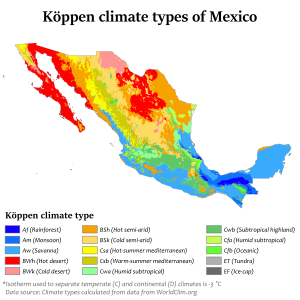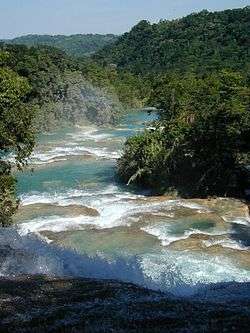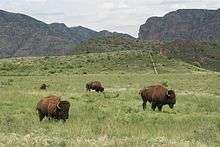Climate of Mexico
The climate of Mexico is very varied.[1] The Tropic of Cancer effectively divides the country into temperate and tropical zones. Land that is north of the twenty-fourth parallel experiences lower temperatures during the winter months. South of the twenty-fourth parallel, temperatures are fairly consistent all year round and vary solely as a function of elevation. The north of the country usually receives less precipitation than the south.

By region
Areas south of the twentieth-fourth parallel with elevations up to 1,000 meters (3,281 ft) (the southern parts of both coastal plains as well as the Yucatán Peninsula), have a yearly median temperature between 24 and 28 °C (75.2 and 82.4 °F). Temperatures here remain high throughout the year, with only a 5 °C (9 °F) difference between winter and summer median temperatures. Although low-lying areas north of the twenty-fourth parallel are hot and humid during the summer, they generally have lower yearly temperature averages (from 20 to 24 °C or 68.0 to 75.2 °F) because of more moderate conditions during the winter.


Between 1,000 and 2,000 meters (3,281 and 6,562 ft), one encounters yearly average temperatures between 16 and 20 °C (60.8 and 68.0 °F). Towns and cities at this elevation south of the twenty-fourth parallel have relatively constant, pleasant temperatures throughout the year, whereas more northerly locations experience sizeable seasonal variations. Above 2,000 meters (6,562 ft), temperatures drop as low as an average yearly range between 8 and 12 °C (46.4 and 53.6 °F) in the Cordillera Neovolcánica. At 2,300 meters (7,546 ft), Mexico City (primarily highland oceanic climate) has a yearly median temperature of 15 °C (59 °F) with pleasant summers and mild winters. Average daily highs and lows for May, the warmest month, are 26 and 12 °C (78.8 and 53.6 °F), and average daily highs and lows for January, the coldest month, are 19 and 6 °C (66.2 and 42.8 °F).
Rainfall varies widely both by location and season. Arid or semiarid conditions are encountered in the Baja California Peninsula, the northwestern state of Sonora, the northern altiplano, and also significant portions of the southern altiplano. Rainfall in these regions averages between 300 and 600 millimeters (11.8 and 23.6 in) per year, although even less in some areas, particularly in the state of Baja California. Average rainfall totals are between 600 and 1,000 millimeters (23.6 and 39.4 in) in most of the major populated areas of the southern altiplano, including Mexico City and Guadalajara. Low-lying areas along the Gulf of Mexico receive in excess of 1,000 millimeters (39.4 in) of rainfall in an average year, with the wettest region being the southeastern state of Tabasco, which typically receives approximately 2,000 millimeters (78.7 in) of rainfall on an annual basis. Parts of the northern altiplano, highlands and high peaks in the Sierra Madres receive yearly snowfall. Citlaltépetl, Popocatépetl and, Iztaccíhuatl continue to support glaciers, the largest of which is the Gran Glaciar Norte.
Mexico has pronounced wet and dry seasons. Most of the country experiences a rainy season from June to mid-October and significantly less rain during the remainder of the year. February and July generally are the driest and wettest months, respectively. Mexico City, for example, receives an average of only 5 millimeters (0.2 in) of rain during February but more than 160 millimeters (6.3 in) in July. Coastal areas, especially those along the Gulf of Mexico, experience the largest amounts of rain in September. Tabasco typically records more than 300 millimeters (11.8 in) of rain during that month. A portion of northwestern Baja California has a Mediterranean climate influenced by the California Current, with a rainy season that occurs in winter and coastal regions receiving considerable fog. Another area of the Mediterranean climate as a result of elevation occurs in the interior of Sonora.
Mexico lies squarely within the hurricane belt, and all regions of both coasts are susceptible to these storms from June through November. Hurricanes on the Pacific coast are often less violent than those affecting Mexico's eastern coastline. Several hurricanes per year strike the Caribbean and Gulf of Mexico coastline, however, and these storms bring high winds, heavy rain, extensive damage, and occasional loss of life. Hurricane Gilbert passed directly over Cancún in September 1988, with winds in excess of 200 kilometers per hour (124 mph), producing major damage to hotels in the resort area. It then struck northeast Mexico, where flooding from the heavy rain killed dozens in the Monterrey area and caused extensive damage to livestock and vegetable crops.

.jpg)




 Valle de Guadalupe
Valle de Guadalupe
Hot-summer mediterranean climate (Csa).jpg)
 Selva Lacandona
Selva Lacandona
Tropical rainforest climate (Af)- Río Bravo del Norte
Humid subtropical climate without dry season (Cfa) 



Weather records
- Temperature
- Heat: 52.5 °C (126.5 °F) in San Luis Río Colorado, Sonora on 15 June 1966[2]
- Cold: −29 °C (−20.2 °F) in Los Lamentos, Chihuahua on 11 January 1962[3]
- Precipitation
- Western Hemisphere record for 24-hour rainfall: 1633.98 mm (64.33 inches) over the time period of 12:30 UTC on 21 October 2005 to 12:30 UTC 22 October 2005 on Isla Mujeres, Quintana Roo during the passage of Hurricane Wilma.[4] Also the record for the Northern Hemisphere.[5]
- Other
- Most intense tropical cyclone in the Western Hemisphere: 879 hPa (25.96 inHg); eye of Hurricane Patricia, 23 October 2015.[6]
Climate change
Climate change in Mexico is expected to have widespread impacts on Mexico: with significant decreases in precipitation and increases in temperatures. This will put pressure on the economy, people and the biodiversity of many parts of the country, which have large arid or hot climates.
Already climate change has impacted agriculture [7], biodiversity, farmer livelihoods, and migration,[8][9] as well as "water, health, air pollution, traffic disruption from floods, [and] housing vulnerability to landslides."[10] Altered precipitation patterns and warming temperatures has led to economic insecurity in Mexico, particularly for smallholder farmers, and have laced significant burdens on Mexico’s economically and culturally important crops: maize and coffee. Climate change impacts are especially severe in Mexico City due to increases in air pollution.[11] Ecological impacts of climate change within Mexico include reductions in landscape connectivity and shifting migratory patterns of animals. Furthermore, climate change in Mexico is tied to worldwide trade and economic processes which relates directly to global food security.
In 2012, Mexico passed a comprehensive climate change bill, a first in the developing world, that has set a goal for the country to generate 35% of its energy from clean energy sources by 2024, and to cut emissions by 50% by 2050, from the level found in 2000.[12][13] During the 2016 North American Leaders' Summit, the target of 50% of electricity generated from renewable sources by 2025 was announced.[14] Various climate mitigation efforts have been implemented throughout the country. Mexico has been considered a leader in climate mitigation and climate adaptation.[15][16][17][18][19]References
- "Climate, Mexico". Britannica. Retrieved 10 November 2015.
- "Verano peligroso; calor se acerca a 50 grados". El Universal (in Spanish).
En los datos históricos de Conagua, la temperatura récord de 52.5 grados centígrados a la sombra fue la registrada en San Luis Río Colorado, el 15 de junio de 1966.
- Datos Contenidos en la Base de Datos Climatológica, a Noviembre de 2011, Climatología Estadística, Los Lamentos, Servicio Meteorológico Nacional, México. Retrieved 20 November 2015
- "A New Western Hemisphere 24-hour Rainfall Record". World Meteorological Organization. 12 November 2015.
- "World Meteorological Organization's World Weather & Climate Extremes Archive". wmo.asu.edu.
- "Catastrophic Landfall Expected in Mexico Friday; Patricia Becomes Strongest Hurricane Ever Recorded". weather.com. Retrieved 23 October 2015.
- Godoy, Emilio (14 Dec 2017). "Climate Change Threatens Mexican Agriculture - Mexico". ReliefWeb. Retrieved 2019-09-28.
- "Climate Change and Migration in Mexico: A Report Launch". Wilson Center. 2013-02-15. Retrieved 2019-09-28.
- Wirtz, Nic (2017-10-16). "Climate change and migration in Mexico: Fifth in our series". Global Americans. Retrieved 2019-09-28.
- "How Is Climate Change Affecting Mexico?". Climate Reality. February 15, 2018. Retrieved 2019-09-28.
- Grillo, Ioan (2015-06-06). "Climate change is making Mexico City unbreathable". Salon. Retrieved 2019-09-28.
- "BBC News — Mexico's president enacts climate change legislation". Bbc.co.uk. June 6, 2012. Retrieved July 12, 2013.
- "In A First For Developing World, Mexico Enacts Climate Change Law". International Business Times. June 6, 2012. Retrieved July 12, 2013.
- McDiarmid, Margo. "U.S., Mexico to source 50% of electricity from clean energy by 2025". CBC News. Retrieved September 8, 2016.
- Jordan, Chuck (2016-12-21). "Mexico, a global climate change leader". TheHill. Retrieved 2019-09-28.
- "Championing Adaptation in Mexico: Protecting Communities from the Impacts of Climate Change". World Bank. July 25, 2018. Retrieved 2019-09-28.
- "Mexico". Climate Action Tracker. Retrieved 2019-09-28.
- Marquez, Martha (December 30, 2011). "Climate Change and Mexico". Climate Emergency Institute. Retrieved 2019-09-28.
- SEMARNAT-INECC (November 2016). "Mexico's Climate Change Mid-Century Strategy" (PDF). Ministry of Environment and Natural Resources and National Institute of Ecology and Climate Change. Retrieved 2019-09-29.